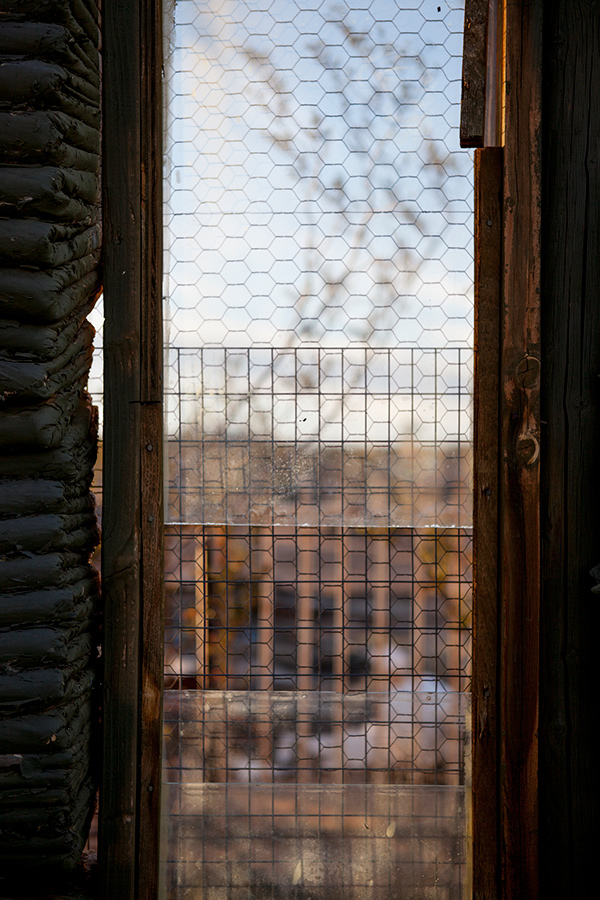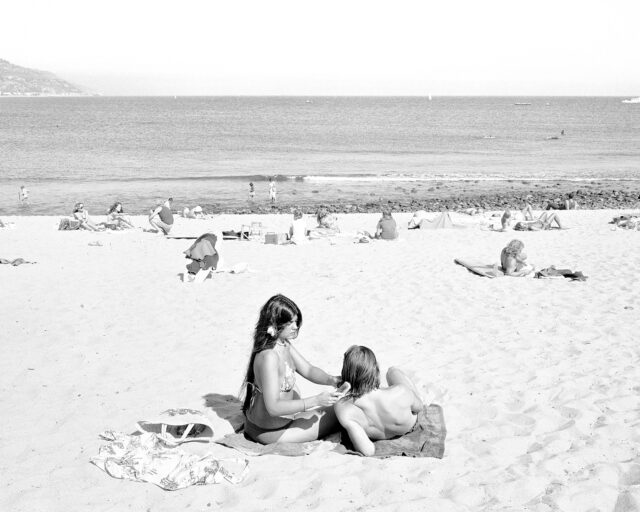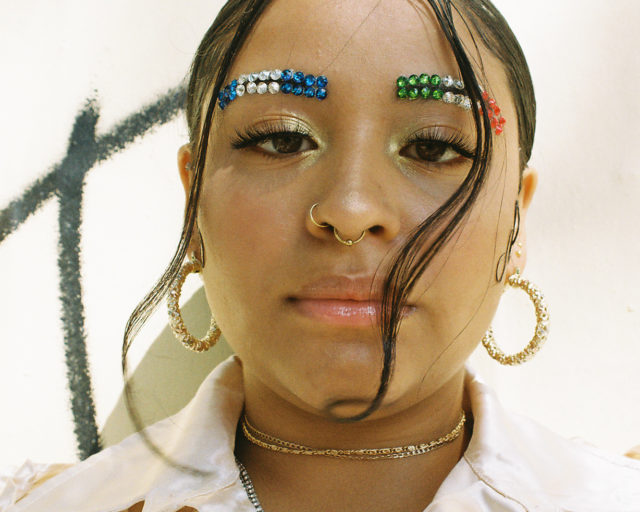Christina Fernandez's Lines of Sight

Christina Fernandez, Steve, 2017, from the series reflect/project(tion)
© the artist and courtesy Gallery Luisotti, Los Angeles
A lifelong Angeleno, Christina Fernandez has, for decades, engaged the transformations of her city’s living conditions with a steadily perspicacious eye. Fernandez’s imagery has put her own experiential narratives into conversation with those of her ancestors, historical figures, and many members of Los Angeles’s Latinx communities, and often gestures to photography’s capacity for evidentiary “truth-telling.” Part of the Getty’s Pacific Standard Time: LA/LA initiative, Christina Fernandez: Prospect, currently on view at Gallery Luisotti, presents two new bodies of work that extend these themes geographically, into multiple desert regions around Southern California, and personally, into the artist’s life as a community college art professor. View from here (2016–ongoing) presents several closely cropped photographs of windows and doorframes within historical structures across the American Southwest. These architectural interstices echo both the photographic frame itself, as well as the perspectives of the buildings’s former inhabitants. The second series, reflect/project(ion) (2016–ongoing), includes portraits of the artist’s photography students, printed on stretched canvas. Collaboratively executed by Fernandez and her subjects, the series reorients economies of prestige that have historically circulated among the Los Angeles area’s renowned art schools.

Christina Fernandez, Coldwell II, 2009, from the series Sereno
© the artist and courtesy Gallery Luisotti, Los Angeles
Jeanne Dreskin: Much of your past work has drawn attention to the geographic specificities around the greater Los Angeles area. How has your relationship to the city’s social and economic concerns evolved over the course of your career, particularly in the last ten years, during which LA has seen unprecedented rates of development and gentrification?
Christina Fernandez: The Sereno series (2006), shot in El Sereno, in northeast Los Angeles, described my role as a participant rather than an observer of these phenomena you describe. There is a homelessness about the images, the sense of something lost, missing, or unattainable. El Sereno is a working-class Mexican and Mexican American neighborhood in Northeast Los Angeles. It is an enclave, a beautiful little space with rolling hills, winding streets, and modest homes with front and backyards. That is now being gentrified.
When I moved there in 2006, the gentrification process had not yet begun. It was simply a beautiful space that I could afford. But then, around 2008, the housing bubble burst and suddenly, within a few years, my home was worth far less than I had paid for it. Over the six-year period that I lived there, I photographed in these in-between spaces (of which there were many) where the refuse of outdated household items was dumped and people who could not afford even this modest community were forced to live outside. Sereno is absent of human figures and describes human presence through things left behind. By foregrounding the refuse against the backdrop of neighborhood homes, Sereno asks, “Who is this place for? Who has access? Who does not?”

Christina Fernandez, Noah (Joshua Tree), 2016, from the series View from here
© the artist and courtesy Gallery Luisotti, Los Angeles
Dreskin: Windows and doors have consistently appeared in your work. Beyond their functionality as architectural fixtures and purveyors of directed vision, what drew you to windows and doorways in View from here and reflect/project(ion)?
Fernandez: They are passageways into another place from where we stand, and a perfect way to break up space in a flat image. For View from here, I photographed Noah (Joshua Tree) (2016) at the Noah Purifoy Desert Art Museum of Assemblage Art, and the window frames another work on view. Cabot I (Desert Hot Springs) and Cabot II (Desert Hot Springs) (both 2017) were photographed at Cabot Yerxa’s Pueblo Museum, a Hopi-inspired pueblo built with repurposed materials in the 1940s. The windows worked to create a specific flow of air for cooling by opening and closing certain windows at different times of day, so the window is almost an instrument played at different intervals to produce the “sound” of cool air.
Yerxa’s building was his penultimate creative expression as an artist, musician, and writer, completely integrated into his daily life. Purifoy’s sculptural environments evoke the idea of home. Both completely take in and acknowledge the landscape as a collaborator, a significant factor in the formation of the structures they created.
Our relation to the built environment is an ongoing negotiation; a home can be a haven or a prison. I suppose the windows can represent a type of escape, but also the prospect of another day, another life, a dream, a vision. With reflect/project(ion), I wanted to evoke the idea of transition, of being on a threshold, to visually tie the two series together, and to connect the ideas in the View from here series. The reflect/project(ion) series depicts young art students. At their age, I always felt like I was an “emerging” artist, professional, adult. When I contemplate their evolution as creative people, I admire their ability to move from one thing to another, their fluidity and depth. I wanted their portraits to reflect this.

Christina Fernandez, CCJ (Leadfield), 2016, from the series View from here
© the artist and courtesy Gallery Luisotti, Los Angeles
Dreskin: In View from here, material characteristics of the window and its components—pane, frame, sill, et cetera—are thrown into sharp relief, while the landscape often remains blurred. These images hint at a given site’s histories through its architecture. How do these photographs function differently than a photograph of the unobscured landscape? Do they invoke a different kind of narrative?
Fernandez: The unobscured landscape is too interesting and specific in and of itself. I am trying to point to the portent or prospect. When the artist Noah Purifoy (1917–2004) or Courtney Chauncey Julian (1885–1934), an early twentieth-century prospector who was a founder of the mining town of Leadfield, CA, arrived at their remote places, what were they hoping to build?
Many of these photographs are taken in remote desert locations. These frames are the threshold between shelter and the elements, life and death, present and future, presence and vision. Photography’s unique ability to simultaneously obfuscate and document creates this tension and abstraction between now and then, here and there, clarity and the unknown, and reveals the problem with historical narratives as truth.
Dreskin: CCJ (Leadfield) (2016), titled after Courtney Chauncey Julian, immediately reminded me of Lee Miller’s photograph Portrait of Space, created near Siwa in Egypt’s Western Desert in 1937. Miller’s title raises questions about the intersections between portraiture and landscape photography. How do they intersect in your own practice?
Fernandez: I view both series as portrait works. The reflect/project(ion) series is more easily understandable as a portrait series. The View from here series—they are portraits in the sense that I imagine the people they are named after looking through these windows onto the outside and into the landscape. In View from here the view is obscured: literally obscured through a device of the camera, but, figuratively, through the passage of time and the changing landscape. Our view is also obscured through history and the formation of our understanding of these historical figures. The view is a stand-in for what they may have imagined, their vision of what they were doing, our interpretation of that moment. The window, because of its vertical orientation, is a stand-in for their bodies.

Christina Fernandez, Alice, 2017, from the series reflect/project(tion)
© the artist and courtesy Gallery Luisotti, Los Angeles
Dreskin: Thinking once more about questions of materiality, your decision to make prints of reflect/project(ion) on canvas lends them an acute tangibility. Why was this kind of tangibility important to you in this case?
Fernandez: Canvas is very different from paper in that it can be stretched over a frame and has buoyancy. I wanted to evoke skin. There is bareness to the photograph without a frame. In the image itself, I am breaking down space by using the projection in the image, but also by the use of the materials—using canvas instead of a traditional frames and matting supports.
The projections of the students’ cameras are phantom-like. At times, the projection partially obscures the photo-lab environment where I photographed. The projection bends and trails off. Because of this multilayered effect, I wanted the surface of the photographs to be more immediate, more accessible. Stretched canvas provides that effect, not only because of its materiality, but because of its familiarity, which we commonly see at coffee houses and grocery stores.
Bodies are evoked in both of these series: windows as portraits of historical figures, as imagined through the obscured views of the landscape, and portraits on canvas with the body of the “camera” projected into and onto the surfaces of the space and portrait subject.

Christina Fernandez, Joseph, 2017, from the series reflect/project(tion)
© the artist and courtesy Gallery Luisotti, Los Angeles
Dreskin: Ruin (1999–2000) and Maria’s Great Expedition (1995–96) explore your own Mexican American background and reveal how disjunctions can arise between personal narratives and the predominant “official” ones. Reconciling these contradictions can be necessarily speculative, and thus new narratives can be produced. In this context, reflect/project(ion) introduces a new structure of inheritance between yourself, a Cerritos College art professor, and your students. Why did you decide to collaborate with your students? How does this collaboration visualize a particular kind of kinship structure?
Fernandez: There is a longstanding history or tradition in the arts of the student-teacher relationship, especially here in southern California, where museum and gallery affiliations get passed down to promising graduate students at certain universities. I teach at a community college. It is a strong program; however, the opportunity for making alliances and discussing work beyond the foundation level is difficult. So, my relationships with students whose work I love have to go beyond the classroom. We keep in touch; they work for me in the lab as technicians. I see them as creative and independent. But, in many ways, they are reflections of the photographic values I taught them. They reflect back ideas and values that they are invested in; my values are translated, reinterpreted, and changed.
In reflect/project(ion), I am photographing the students, but I am also projecting an image that they created onto them. Originally, I asked them to photograph their camera in front of a light-colored background. They brought back what I asked of them, but also other types of photographs: a camera attached to a cable release with a hand depressing the cable release, the back of the camera opened with film bursting out of it, an enlarger as or instead of a camera.
There are very few Latinx Americans in university teaching positions in the arts, so the opportunity for that kind of relationship at the university level is almost nonexistent. There is something to be said about shared experiences—cultural, economic, or academic—and it is especially important for students whose families have very little or no academic or art experience. I want them to know that their ideas are valuable. They are amazing, creative people who I care for.
Christina Fernandez: Prospect is on view at Gallery Luisotti, Los Angeles, through November 22, 2017. The Getty initiative Pacific Standard Time: LA/LA is a collaboration across southern California institutions exploring Latin American and Latinx art in dialogue with Los Angeles.


























